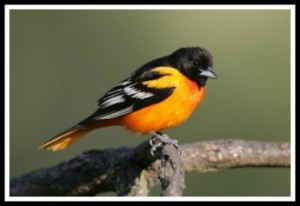Welcome to the Red-Winged Blackbirds!
 I have been monitoring the arrival of the Red-winged Blackbirds to Serendipity Gardens for five years now. Each year, without fail, they have arrived on March 4 or within a day of that date. I hear their raucous call and know that spring is on its way.
I have been monitoring the arrival of the Red-winged Blackbirds to Serendipity Gardens for five years now. Each year, without fail, they have arrived on March 4 or within a day of that date. I hear their raucous call and know that spring is on its way.
This year — the 3rd snowiest on record with temperatures below zero many mornings — that hopeful message has been more welcome than ever.
The call of the Red-winged Blackbird reminds me of sandpaper. It is not musical at all — yet I love to hear it!
Learn about the spring behavior of these birds. (Video taken from BirdNote; credit goes to the Cornell Lab of Ornithology.)
The Perfect Habitat
We have a stream that runs north and south along the western edge of our property. About halfway, it turns eastward and splits our garden proper from a fallow field that lies behind it. At the east boundary, it turns southward again. After it leaves our property, it runs into what looks like a wetland (based on a Google Earth photo). It’s marshy land back there, squishy underfoot, especially in the springtime — a perfect habitat for these noisy birds.
According to All About Birds, Red-winged Blackbirds are either year-round residents or short-distance migrants. Birds from the northern reaches of North America often overwinter in the southern United States, flying as much as 800 miles from their nesting grounds. I know my birds are migrants, because their voices cease in mid-August when they leave.
The most amazing thing to me is the fact that they arrive so close to the same day each year. How do they do it? Scientists do not yet fully understand migration patterns. But it is likely that some combination of more daylight hours, warmer temperatures, and perhaps hunger for insects instead of grain triggers the northern flight of Red-winged Blackbirds in the spring.
Whatever the reason, their timing has been right on the money, for the last five years at least.
They must have been surprised this year to find the land still snow-covered and temperatures frigid. They’ll hunker down in the grasses, I suppose, while they wait out the demise of Old Man Winter.
frigid. They’ll hunker down in the grasses, I suppose, while they wait out the demise of Old Man Winter.
Attracting Members of the Blackbird and Oriole Family to Your Yard
The Blackbird family includes Red-Winged Blackbirds as well as more common birds like cowbirds and grackles. Grassland relatives include meadowlarks and bobolinks. The family also includes one bird that most any bird-loving homeowner would be glad to welcome, the Baltimore Oriole, America’s only large orange bird.
Unlike their cousins, Baltimore Orioles have a musical song.
Listen to the Baltimore Oriole sing.
 Sally Roth, author of Bird-by-Bird Gardening, has these glowing words to say about Baltimore Orioles: “These flamboyant birds have fabulous orange or yellow feathers, contrasted with a dramatic black hood and back, and flashy black and white wings … They are strong flyers, so you’ll often see them on the wing as they move from tree to tree. Their musical songs are loud and sweet … All in all, it’s quite a package.”
Sally Roth, author of Bird-by-Bird Gardening, has these glowing words to say about Baltimore Orioles: “These flamboyant birds have fabulous orange or yellow feathers, contrasted with a dramatic black hood and back, and flashy black and white wings … They are strong flyers, so you’ll often see them on the wing as they move from tree to tree. Their musical songs are loud and sweet … All in all, it’s quite a package.”
Here are some tips on attracting these orange beauties to your yard:
- Plant your yard with deciduous trees and shrubs of different heights.
- Plant bright fruits, such as strawberries, and nectar-bearing flowers such as raspberries, crab apple, and trumpet vine.
- Cut an orange in half and hang it from a tree.
- Put out a feeder especially for orioles to entice them with sugar water or jelly.
- Offer six-inch pieces of white twine for them to use in building their distinctive pouch-shaped nests.
- Keep your birdbath filled to the brim. These water-loving birds like to take a bath frequently.
On the Lookout for Both Birds
I think I had an oriole in my yard last year. I know I saw a couple of flashes of orange and spent some time looking in my bird book to determine what it was. I’ll keep looking this year — and I think I’ll try hanging an orange in a tree. But I’ll also be watching and listening on March 4, 2015, to see if the Red-winged Blackbirds make it to Serendipity Gardens on time six years in a row.
I always like to see the Red Winged Blackbirds return because I know spring is not far away.
I have a hummingbird feeder outside of my office window, the Red Wing Blackbirds love it!!! I was expecting Hummingbirds, but it’s fun to watch the Blackbirds drink from it.